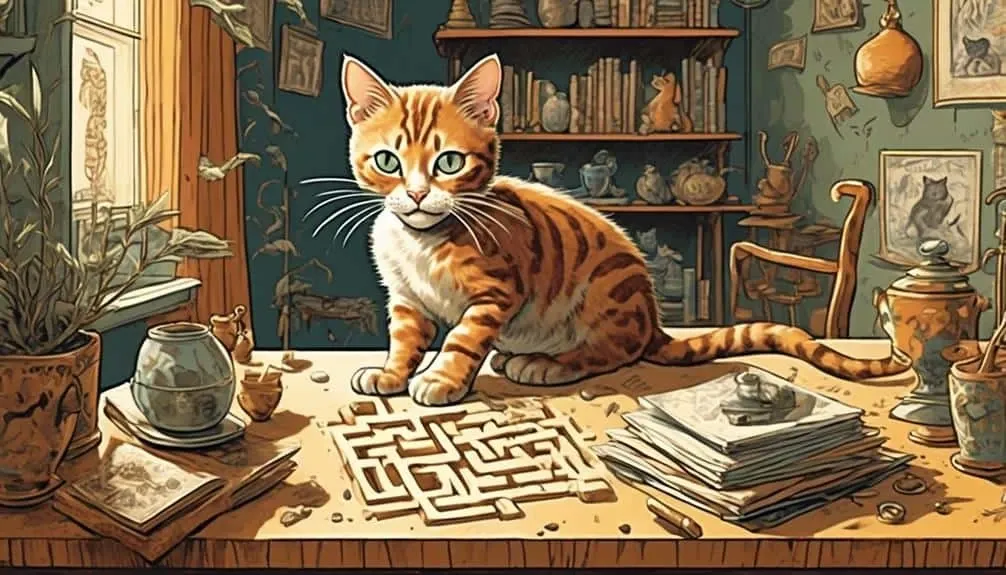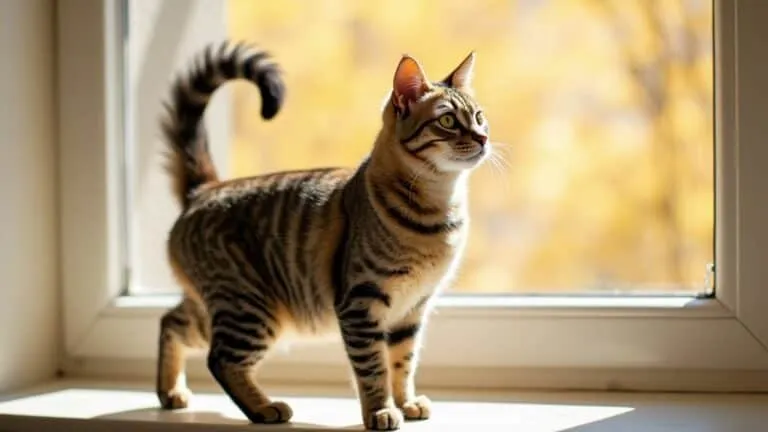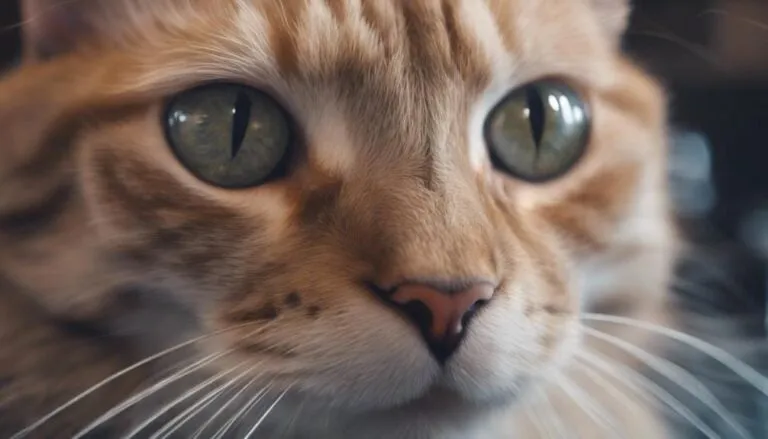The Best Fluffy Pancakes recipe you will fall in love with. Full of tips and tricks to help you make the best pancakes.

Do you ever find yourself wondering why your cat seems to enjoy being chased during playtime? It's almost as if they're taunting you, daring you to catch them. But is there more to this behavior than meets the eye?
In this article, we will explore the fascinating world of feline play and attempt to unravel the mystery behind their craving for being chased. From understanding their instinctual need for play to deciphering their body language, we will delve into the intricate world of cats and their playful desires.
So, are you ready to discover the truth behind this enigmatic behavior?
Key Takeaways
- Play is essential for cats as it satisfies their natural hunting instinct and helps them develop important skills.
- Cats may have different preferences and motivations for play, and it is important to pay attention to their body language and signals to understand their needs.
- Cats with high motivation to play require more physical activity and playtime to keep them happy, while cats with low motivation may need more stimulation and interactive games with the owner.
- Playing chase with cats can be beneficial for their physical and mental well-being, but it is crucial to respect their boundaries, avoid scaring them, and ensure that everyone in the household is on the same page about appropriate play.
The Instinctual Need for Play
The instinctual need for play is an essential aspect of a cat's overall well-being and development. Play behavior in cats serves various purposes and has numerous benefits.
Kittens, in particular, learn important hunting skills through play, such as chasing and pouncing. This play helps them develop the necessary skills to hide and avoid predators.
For adult cats, play remains pleasurable and helps them stay active and energetic. Play also provides mental stimulation, preventing boredom and potential depression in cats.
Additionally, interactive play with owners can strengthen the bond between the cat and the human, promoting a positive relationship. Therefore, understanding the role of play in cat development and actively engaging in play sessions with your feline companion can greatly contribute to their overall health and well-being.
Understanding Your Cat's Play Preferences
Understanding your cat's play preferences is essential for providing them with appropriate and enjoyable play experiences. Building trust and setting boundaries are crucial aspects of understanding your cat's preferences.
To build trust, spend quality time with your cat and provide positive reinforcement during play sessions. Observe your cat's body language to determine their enjoyment of being chased. Signs of enjoyment may include playful vocalization, dilated pupils, and sudden movements.
However, it's important to respect your cat's personal space and desire for alone time. If your cat shows signs of stress or aggression during chase games, it's best to avoid engaging in this activity.
Recognizing Signs of Enjoyment
To determine if your cat enjoys being chased, pay close attention to their body language and behavioral cues. Recognizing signs of enjoyment can help you understand if your cat finds chase games pleasurable. Here are some key indicators to look out for:
- Playful Vocalization: If your cat is making chirping sounds or engaging in playful meowing during the chase, it's a positive sign that they're enjoying the activity.
- Dilated Pupils: Cats often have dilated pupils when they're excited or having fun. If you notice their pupils getting larger during the chase, it indicates that they're enjoying the interaction.
- Sudden Movements: A cat that's enjoying being chased may display sudden bursts of energy, such as running, jumping, or rapidly changing direction. These movements show their enthusiasm for the game.
Understanding these signs of enjoyment is essential for building a strong bond with your cat through play. Interactive play not only provides physical exercise but also strengthens the emotional connection between you and your feline companion. It's a fun and beneficial way to engage with your cat and provide them with mental stimulation.
Interpreting Your Cat's Body Language
When observing your cat's behavior during chase games, it's crucial to interpret their body language accurately to ensure a positive and enjoyable experience for both you and your feline companion. Interpreting your cat's body language during playtime is essential for creating a safe play environment.
Pay close attention to their posture, tail movement, and facial expressions. A relaxed and playful cat will have a loose body posture, an upright tail with a slight curve at the tip, and dilated pupils. Playful vocalizations and sudden movements are also signs of enjoyment.
On the other hand, signs of discomfort or agitation include a tucked tail, flattened ears, and hissing or growling. It's important to respect your cat's signals and avoid pushing them beyond their comfort zone.
Avoiding Aggression and Fear
Avoiding aggression and fear in cats during chase games requires careful observation of their body language and respecting their comfort levels. Building trust and establishing boundaries are essential for creating a safe and enjoyable play environment. Here are three key considerations to keep in mind:
- Observe body language: Pay close attention to your cat's signals during playtime. Signs of discomfort or fear, such as tail whipping and flattened ears, shouldn't be ignored. Ignoring these signs may lead to scratching or biting, which can escalate aggression.
- Respect personal space: Cats have their own preferences for personal space and alone time. It's important to respect their need for privacy and not force them to engage in chase games if they show signs of avoidance or stress. Running away from you doesn't necessarily mean they want to play.
- Set clear boundaries: Establishing boundaries is crucial to prevent fear or aggression during chase games. Avoid encouraging biting or scratching behaviors and ensure everyone in the household is on the same page about appropriate play. By setting clear boundaries, you can create a positive and safe environment for your cat.
Meeting the Play Needs of High Motivation Cats
Highly motivated cats require ample physical activity and playtime to fulfill their play needs and keep them happy and engaged. High energy cats are often active and energetic, enjoying play at any time of day and easily engaging with toys. These cats may require more physical activity and playtime to keep them satisfied.
Providing opportunities for interactive play with their owners can be especially beneficial for cats with high motivation. Incorporating positive reinforcement, such as treats, can help motivate these cats to engage in play. Short and fun play sessions can also be effective for meeting the play needs of high energy cats.
Meeting the Play Needs of Low Motivation Cats
Cats with low motivation to play may require additional stimulation and attention to meet their play needs and prevent boredom or depression. To help engage these cats in interactive play, consider the following:
- Interactive Play:
- Engage in play sessions that involve toys and activities that require the cat's participation, such as puzzle toys or feather wands.
- Provide variety in play by introducing new toys or rotating them to maintain interest.
- Incorporate hiding and seeking games to stimulate the cat's natural hunting instincts.
- Positive Reinforcement:
- Use treats or praise as rewards during play sessions to motivate the cat and reinforce their participation.
- Gradually increase the difficulty or challenge of play activities to keep the cat engaged and interested.
- Consistently reward the cat for their efforts to encourage continued play.
- Short and Fun Play Sessions:
- Cats with low motivation to play may benefit from shorter, more frequent play sessions throughout the day.
- Keep play sessions exciting and engaging by ensuring they're fun and interactive for both you and the cat.
- Adjust the length and intensity of play based on the cat's interest and energy level.
Frequently Asked Questions
How Can I Determine if My Cat Enjoys Being Chased During Playtime?
To determine if your cat enjoys being chased during playtime, pay close attention to their body language. Signs of enjoyment may include playful vocalization, dilated pupils, and sudden movements. Observe their ideal playtime and preferences to better understand their chasing needs.
What Are Some Signs of Discomfort or Fear in Cats During Chase Games?
If your cat shows signs of discomfort or fear during chase games, it's important to pay attention. Watch for warning signs like tail whipping and flattened ears. Ignoring these signs may lead to scratching or biting.
Can Playing Chase With My Cat Lead to Aggression or Biting Behaviors?
Playing chase with your cat can lead to aggression or biting behaviors if they show signs of discomfort or fear. It's crucial to build trust and pay attention to your cat's reaction, ensuring their enjoyment and safety during playtime.
How Can I Prevent Scaring My Cat During Chase Games?
To prevent scaring your cat during chase games, start by building trust during playtime. Pay attention to their body language and signs of discomfort. Respect their personal space and avoid surprise elements that trigger fear.
What Are the Potential Negative Effects of Anxiety and Stress-Related Behaviors in Cats?
Negative effects of anxiety and stress-related behaviors in cats include decreased appetite, weight loss, excessive grooming, urinary issues, and aggression. Managing stress through environmental enrichment, play, and positive reinforcement can help alleviate these effects.
Conclusion
In conclusion, while cats may not necessarily crave being chased, play is an important aspect of their lives. Understanding your cat's play preferences and recognizing signs of enjoyment are crucial for creating a positive play experience.
By interpreting their body language and avoiding aggression or fear, you can ensure that chase games are enjoyable and stress-free for your feline friend. Whether your cat has high or low motivation to play, meeting their play needs is essential for their overall well-being.
So, let the playful adventures begin!








